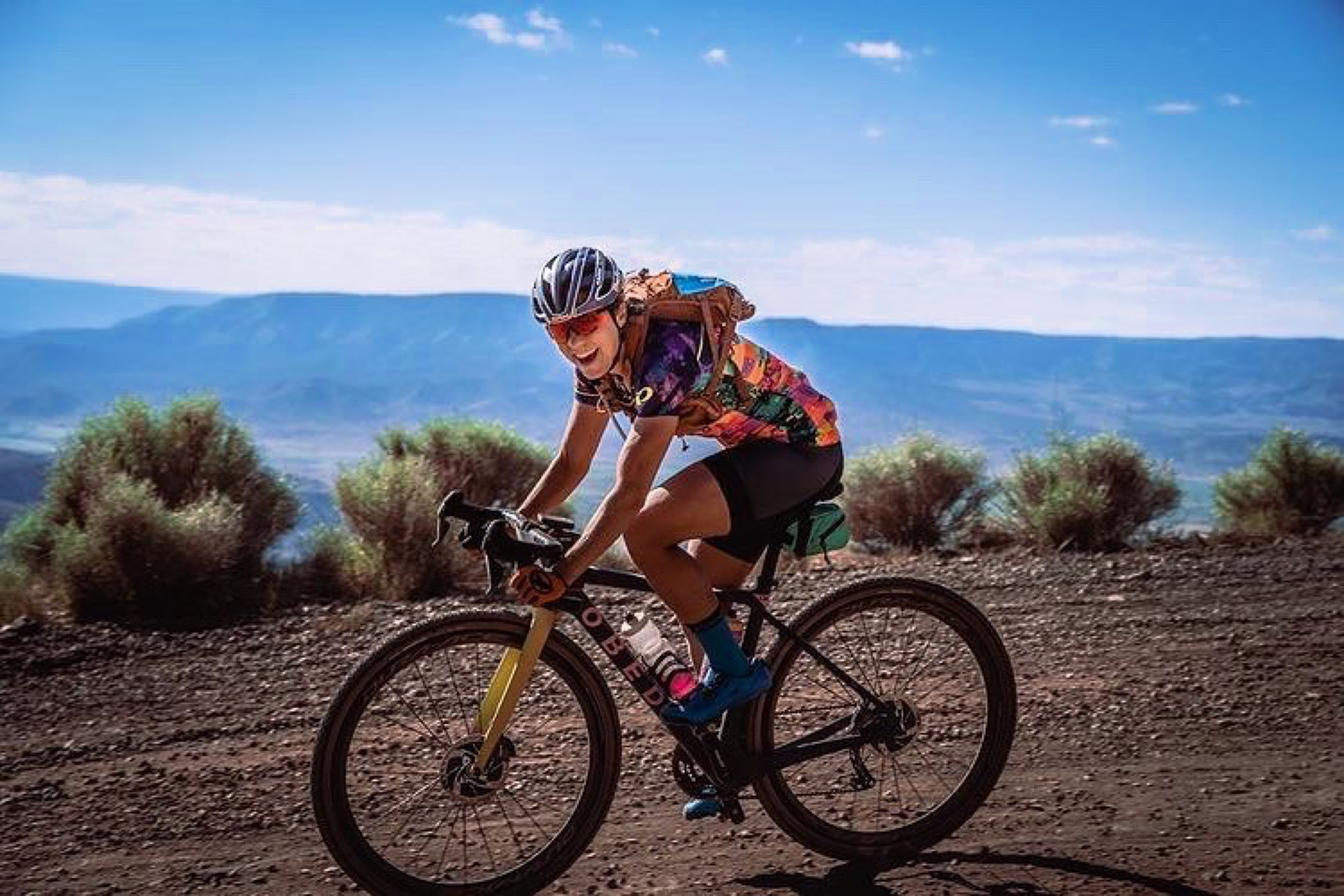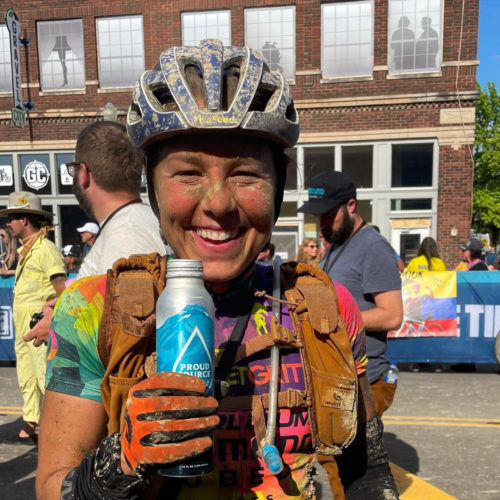Off-Road Cycling for the On Road Athlete
Pro triathlete turned pro MTB/gravel racer, Angela Naeth, shares how off-road cycling is the perfect complementary sport for triathletes.

One of the fastest growing sectors within the cycling industry is off-road or gravel bike riding, and for good reason, it’s a great workout and it’s a ton of fun. According to the NYT, gravel bike sales jumped over 109 percent from 2019 to 2021.
This year, USAT made a push to get people off-roading in its inaugural 2022 Triathlon Gravel Triathlon Series, which offers endurance sports enthusiasts a new way to experience multisport racing at gravel events across the US. But how does this new center point of cycling fit in with the other aspects of endurance sports? Are they mixing it in as cross training? Are there benefits to this subset of riding? We wanted to seek out answers to these questions, so we sat down with veteran professional endurance athlete and avid gravel rider, Angela Naeth.
We’re not talking about your everyday athlete…
Since coming on to the triathlon scene in 2008, Naeth has been a top performer and achieved professional podiums and countless overall wins in both the full Ironman and 70.3 distance. Her not-so-secret super power has always been her abilities on the bike. She has set course record bike splits and has ranked in the top 10 among professional female triathletes. Suffice it to say, Naeth is not your average bear when it comes to riding on two wheels.
After years of dominating multisport, she found herself face to face with a new challenge when she was invited to partake in the Unbound Gravel Race in Emporia, Kansas. With little to no off-road experience, she knew she would be heavily reliant on her V8 engine for legs and a sense of determination to successfully tackle the course. She accepted the challenge and took down the 200 mile race course in June of 2021. Afterwards, she was hooked.

In 2022, Naeth took on the ultimate challenge: the FULL Grand Prix Series plus a full workload as a pro triathlete. For context, the Life Time Grand Prix in 2022 consisted of six gravel and mountain bike races (including the Iconic Leadville 100). That totals over 500 miles of racing and 40,000 feet of elevation gain. For us mortals (and most professionals), that is an entire season. For Naeth, that was only 50 percent of her race season. She also competed in five full distance Ironman events and a 70.3 (three of which she was in the top 10).
It was an epic season but she will be the first to admit, perhaps she had bitten off more than she could chew. For the upcoming 2023 season, she plans to re-evaluate training load and prioritize rest and recovery in between big efforts.
The terrain should not be underestimated
One of the most apparent differences is the terrain, and riders must approach each stretch of “road” differently. “A lot of times in triathlon I find that we really put our viewpoint really close to our front wheel just because we are looking at our data, our hips down in aero. We are looking ahead but it’s definitely very close,” said Naeth. “Whereas in gravel or mountain bike, you have to look ahead to see what’s coming. If you’re looking down at your wheel, you’re going to fall.”
The rider must learn to effectively shift the bike to handle sharp turns, narrow passageways or uneven ground.
When talking about the 200 mile race, Naeth said, “We went through peanut butter mud. My bike could not move. There was grass and mud. There are river crossings. There is super smooth gravel, rocks, slate, mud, grass… you just don’t know what you’re getting into,” said Naeth.
“Learning how to keep the center of gravity on top of the bike as you turn [is key]. Part of it is practice and learning what the bike can handle. If you can keep your center of gravity solid, you won’t slide out. The more you ride, the more you learn about the bike. I am still learning,” said Naeth.
Unlike long course triathlons, which consist of a long steady aerobic effort, off-road cycling is much more dynamic. Riders must surge and recover regularly, and group riding is common.
Naeth said, “With Ironmans, you really want to find this threshold where you can sustain it for this set amount of distance. You want to keep this steady effort. With gravel racing and mountain biking, you sprint with a group and then hold back. The whole mentality has to change. In gravel riding you work with groups. You really need a variety in range in ability. And be OK mentally to sit on someone’s wheel for a while,”
Integrating off-road cycling into your training plan
Time on the bike is beneficial: log lots of miles on and off-road to get your aerobic base and muscles prepped and ready. But as you approach race day, training should become more specific, which means less time on the road, and more time off. This will also help with the handling skills required with off-road riding.
These races will take more out of you than a typical long road ride. Don’t be so quick to swap out a long ride for a gravel ride; even if you take it easy, the effort does not exactly match up. Neath agrees that a general guideline would be to choose a race distance that is 20 to 30 percent shorter than what you are comfortable riding on the road. Also take this into account in your recovery and subsequent training.
That being said, plan your race calendar accordingly. Don’t compete in a gravel race too close to an A race in triathlon. Your body needs time to recover from the wear and tear incurred on gravel.
Oh, and do your best to mentally prepare for the mass start. Said Naeith, “The mass start is insane. You have 2,000 participants on bikes with a variety of understanding of bike technique, and everyone has different abilities and everyone wants to get out as fast as they can. It is still really scary.”

Roll-over benefits of off-road riding
By nature, off-road cycling is much more polarized than steady state riding. You’ll be pushing full power well over your threshold for minutes at a time, and coasting along at others. This will naturally develop your strength as a rider in those various zones.
Off-road racing is hard, much harder than road racing. The intensities and conditions will push you past what you thought you were capable of. This reset of your pain threshold carries back over to the road, allowing you to push your steady state a bit harder for a bit longer.
At the end of the day, we do this for fun. Go to any of these races and you’ll be hard pressed to find a racer—covered head to toe in mud and dirt—not having fun. It’s all about celebrating each other as athletes. The atmosphere is a huge draw for participants.
If you are considering adding some off-road races to your calendar for 2023, join the queue. With the explosion of popularity, most of these races operate with a wait list and lottery system so make sure to get your name in the ring sooner than later to give yourself a chance.
The local off-road community is on the rise as well. Check out your local MTB or gravel races which offer a great entry into the sport right in your backyard.
“The vibe you get at the pre-race, like when you pick up your packets and all that, it’s just fun. You have a totally new concept of racing when you go to these events. You have people who just love the sport…they are very low key. Triathlon is a little more intense. It’s a different concept of racing. You still get competitiveness but you get to the finish line passing beer to each other,” said Naeth with a chuckle.

